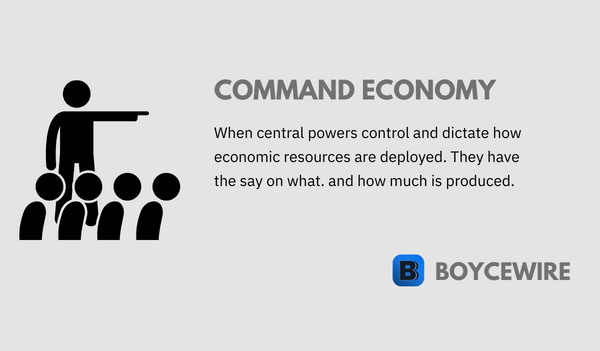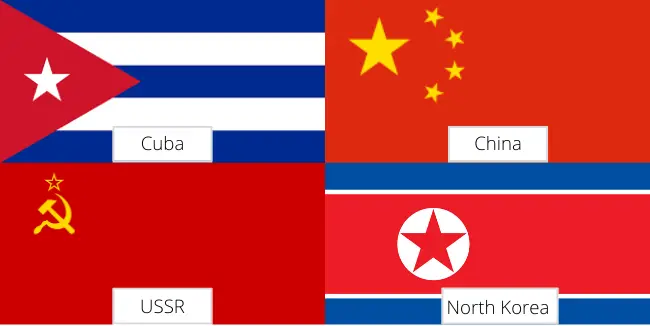Command Economy: Definition, Examples, Pros & Cons

What is a Command Economy
A Command economy is where economic resources are controlled by centralized powers. That means business, employees, and capital is owned and controlled by the government. It answers all economic questions such as where resources go, who they go to, and how they are created.
In a command economy, the government decides how much of a good to produce. For instance, it may want to increase the production of steel in order to build new motor vehicles. At the same time, it directs workers to those means. So someone working on a farm may be asked to work in the steel factory.
At the same time, a command economy decides how much food each individual gets and what type of home they live in. Individuals have no say, whether through democratic means or economically.
In a capitalist society, we are able to vote for products we like by purchasing them. Products that people like stay, and the ones we don’t, tend to disappear from the shelves. By contrast, in a command economy, we get what we are given. So in the government says no Coca-Cola or McDonald’s; that means no Coca-Cola or McDonald’s.
With that said, there are both advantages and disadvantages to a command economy. We will look at these next.
Key Points
- A command economy is where governments or other central powers control the resources in society.
- A command economy is run with a central plan in mind. This is a central economic objective which is the aim for allocating resources and production.
- Examples of a command economy include the likes of China, North Korea, Cuba, Russia, and Vietnam.
Command Economy Advantages
Complete government control over the economy and our lives may seem like hell to many. In a way, it is, but that is not to say it doesn’t have its advantages.
1. Ability to Change Quickly
With a command economy, it’s comparatively quick to adapt and change rapidly. Unlike a market economy, there are no legal or political barriers to overcome. They don’t have to get approval from Congress or go through court proceedings. They are simply able to do it!
This can be particularly useful in times of war. In a Command economy, the government can move all resources from manufacturing luxury goods and towards gun shells and bombs. By contrast, this can take a lot longer through a democratic market economy.
The government of a command economy can switch production at the drop of a hat. However, the main issue is the logistical headache that goes with it.
2. Low Levels of Inequality
In a command economy, wealth is generally shared equally throughout. Workers earn roughly the same even though one may be contributing more in value than others.
The main goal of a command economy is that of the greater public good. Which is why lower levels of inequality exist. However, the main issue with that is everyone may in fact become equally poor as a result. Lower levels of inequality may be a good thing, but only if everyone benefits from higher levels of production and economic output.
3. Common Good versus Profit
From a purely philosophical point of view, a command economy emphasizes the common good over profit. Depending on your philosophical beliefs, this could be either an advantage or a disadvantage.
For some, the common good creates a better living environment for everyone. With everyone helping each other, we may live in a kind and friendly society. However, others believe that this is not practical in reality and does not coincide with human behavior. The best way to help society is through the profit mechanism. The evidence is shown by the advances over the last two hundred years.
Command Economy Disadvantages
Whilst a command economy has some advantages, there are equally as many disadvantages. In fact, these disadvantages show why command economies no longer exist in the modern world.
1. Stifle Innovation
When economic decisions are controlled centrally, we take away the innovation of millions of citizens. Entrepreneurs and innovators are stifled as they cannot start their own business or get funding new ideas.
An innovator may need certain goods and funding in order to pursue their idea. However, without government authorisation, these ideas are nothing more.
2. Corruption
When power is centralized, it is also greatly enhanced. There is more power to be had and there will always be individuals who crave it. In turn, this can lead to scheming, bribing, and general corruption in order to get to the top.
In countries such as China, the power of knowing a local official cannot be underestimated. If you are friends with one, it is much easier to climb the socioeconomic ladder. And even though President Xi has started to fight corruption, it is still prevalent in the nation.
3. Incentives
Under a command economy, the incentives are almost not existent. The main goal is to benefit society. However, these are faceless people. Why should you work hard so that Bob on the other side of the country can eat well tonight?
We are more willing to help neighbors and friends; people we know. Yet millions of strangers; not so much.
The incentives are almost not existent, which is reflected in the output. This is because the motivation is much lower when we are effectively working for someone else. When the work we do is going into our pocket, we tend to work harder. In turn, the overall wealth of the nation and output of the economy become affected.
4. Lack of Choice
One of the biggest drawbacks of a command economy is the lack of freedom and choice. In nations such as the USSR (modern-day Russia), consumers were able to buy products but only had one choice. That means one toothpaste, one type of yogurt, and one type of bread.
Everything is simplified to meet a standard process. This leads to an unsatisfied consumer base. Imagine your favorite chocolate brand no longer exists, but rather you have to stick with the cheap basic brand.
The reasoning for such is that having multiple product lines is a complexity that doesn’t need to exist. Imagine having to run an economy and then think of all the different types of yogurt you have to manufacture and then the types of bread.
Command Economy Characteristics
1. Central Economic Plan
When a nation’s entire economy is centrally planned, it naturally needs a central economic plan. We might think of the USSR’s five-year economic plans that started under Joseph Stalin in 1928.
The aim is to create targets for industry, such as increase the output of coal and agriculture, and then allocate the resources to do so. In fact, the USSR was arguably successful in some aspects of its economic plan as it became an industry leader.
Such central economic plans are a crucial aspect of a command economy. Without it, there is no structure or organization. In turn, this means the philosophical goals that are associated with a command economy, such as equality and the common good, cannot be achieved.
To put it into perspective, imagine trying to run a large company such as Walmart or Alibaba. Now imagine trying to run ten of them at the same time. It’s a logistical nightmare, which is why a plan is part of the process by which the government tries to make it more manageable.
2. Government Allocates Resources
A command economy has a central plan and that plan is implemented through the allocation of resources. That means labor is directed by the government to where it sees fit. For instance, someone working in Moscow may need to move to the far-east town of Anadyr in Russia.
In fact, this is exactly what the USSR did during the Second World War. As it feared German invasion from the west, it moved industry eastwards to ensure it could still supply itself with resources.
This is a common characteristic of a command economy. By allocating resources where it sees fit, it is able to meet the targets it sets in its economic plan. These targets may be for the common good, or as with the case of the USSR, to protect itself in times of war.
At the same time, the aim is to reduce waste that occurs in a capitalist society by ensuring complete full employment.
3. Central Plan sets priorities
Governments in a command economy set central plans. These usually range from five to ten years with a specific target. For instance, increase manufacturing production and bring down unemployment.
The idea of the central plan is to allocate specific resources so it can set a priority for the production of goods and services. For example, the nation may want to focus on extracting its natural resources, so would want to allocate labor and capital to those means. This might require reallocating and retraining workers who were previously in manufacturing.
4. Monopoly
In a command economy, every industry is monopolized by the government. That means banking, manufacturing, utilities, and transportation are all controlled centrally. There is no competition, which means all decisions are made by bureaucrats rather than responding to competitive pressures.
Consequently, a command economy faces many of the same drawbacks and advantages as a normal monopoly. Their incentive to improve efficiency is diminished due to the lack of competition and the profit motive. However, it is able to mitigate some of these inefficiencies due to large scale production where economies of scale may be achieved.
5. Legal and Social Restrictions
As with any command economy, there are many legal restrictions. For instance, the ownership of private property is forbidden. At the same time, with a command economy, there is strong control over the media. Propaganda is often used to promote how well the country is doing.
North Korea famously promoted how it won everything from the soccer World Cup to Olympic gold medals. Of course, they were lies but shows the extent some nations go to.
No matter the economic structure, there will be discontent among the public. Whilst most developed nations today allow some level of freedom of speech, command economies tend to shut it down in order to keep the peace.
Command Economy Examples

A command economy and a communist structure go hand in hand. They are one of the same. So when looking at examples, we can include most communist and socialist nations.
In a command economy, the government decides on how much to produce, what to produce, and at what price to sell it for. Characteristics that are very
Cuba
Founded in 1965, the Communist Party of Cuba rule over the nation. Industry is centrally owned and state-run with a centralised economic plan.
North Korea
North Korea is perhaps one of the most prominent examples of a command economy. It is extremely restrictive and controls the economy with a steel fist. Propaganda is equally strong, with central powers even claiming they won the soccer World Cup.
China
China is run by the Communist Party of China under leader President Xi. Whilst it isn’t as strict as a traditional communist nation, it still operates under strict centralised control and regulation. Foreign companies can only invest if they meet strict requirements, whilst it maintains control over most of industry.
USSR
The USSR was the gold standard of a command economy back in the 20th century. It created 5-year economic plans and diverted resources all across the country. The lack of choice was infamous within its society. There was one choice of toothpaste, one choice of bread, and one choice of yogurts.
Vietnam
Vietnam is another example of a command economy. It is a one-party communist state whereby government dictates the allocation of resources through the nation. Vietnam has a complete monopoly in the economy and within the political sphere. It uses that power to supress religion, freedom of speech, as well as the media.
FAQs
Examples of a command economy include:
– Cuba
– China
– North Korea
– the USSR
– Vietnam
The main idea of a command economy is that the economic foundation is controlled by government and central powers. They get to decide on economic decision making such as how many cars should be made, or how resources are distributed throughout society.
The 5 characterisitcs fo a command economy include:
– Central Economic plan
– Government allocates resources
– Central Plan sets priorities for production
– Government owns a monopoly
– Governments create laws to enforce central plan
About Paul
Paul Boyce is an economics editor with over 10 years experience in the industry. Currently working as a consultant within the financial services sector, Paul is the CEO and chief editor of BoyceWire. He has written publications for FEE, the Mises Institute, and many others.

Further Reading
 What Role Does Competition Play in International Trade - Competition plays a key role in promoting innovation, efficiency, and lower prices in international trade, benefitting both consumers and firms.
What Role Does Competition Play in International Trade - Competition plays a key role in promoting innovation, efficiency, and lower prices in international trade, benefitting both consumers and firms.  Deadweight Loss: What it is, Formula & Examples - A deadweight loss is a loss in economic efficiency as a result of disequilibrium of supply and demand. In other…
Deadweight Loss: What it is, Formula & Examples - A deadweight loss is a loss in economic efficiency as a result of disequilibrium of supply and demand. In other…  Mixed Economy: Definition, Pros, Cons & Examples - A mixed economy is an economic system that combines elements of a capitalist, market-based system, with a socialist, command economy…
Mixed Economy: Definition, Pros, Cons & Examples - A mixed economy is an economic system that combines elements of a capitalist, market-based system, with a socialist, command economy… 
